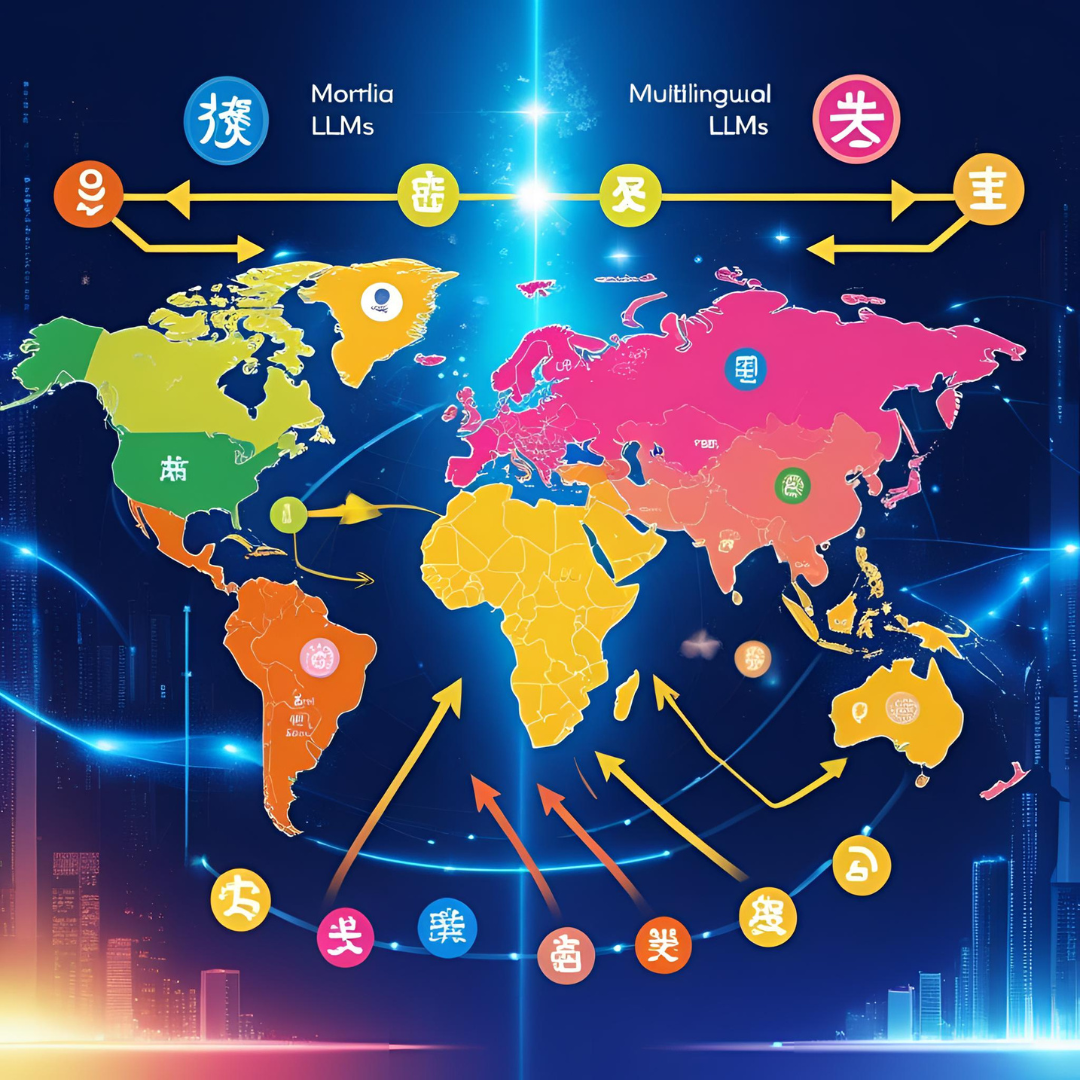The evolution of Large Language Models (LLMs) has undergone a remarkable transformation in recent years, particularly in the realm of multilingual capabilities. Models like GPT-4, PaLM, and Claude not only excel in English but also demonstrate proficiency in understanding and generating text across dozens of languages. However, behind these impressive capabilities lies a complex web of technical challenges and unique considerations in training and evaluating multilingual models.
Architecture and Training Approaches
Multilingual Pre-training Strategies
Training multilingual models begins with pre-training on corpora spanning multiple languages. The primary approaches include:
Shared Vocabulary Architecture: Utilizing tokenizers capable of handling multiple languages within a unified vocabulary space. Techniques like SentencePiece and Byte-Pair Encoding (BPE) enable models to learn efficient sub-word representations across languages.
Cross-lingual Transfer Learning: Models learn universal linguistic patterns that transfer between languages. This allows understanding of low-resource languages by leveraging knowledge from high-resource counterparts.
Multilingual Training Objectives: Beyond traditional language modeling objectives, multilingual models often employ additional objectives such as Translation Language Modeling (TLM) and cross-lingual Masked Language Modeling (MLM).
Data Preparation Challenges
One of the most significant hurdles is the imbalanced distribution of data across languages. English dominates internet content, while languages with fewer speakers have minimal representation. Strategies to address this include:
- Temperature Sampling: Balanced exposure to different languages during training
- Data Augmentation: Techniques like back-translation and code-switching to enrich minority language datasets
- Quality Filtering: Robust filtering pipelines to ensure multilingual data quality
- Synthetic Data Generation: Creating artificial training data for underrepresented languages
Evaluation Methodologies for Multilingual Models
Benchmarks and Evaluation Metrics
Evaluating multilingual models requires more nuanced approaches than monolingual assessment:
Cross-lingual Understanding Tasks:
- XNLI (Cross-lingual Natural Language Inference)
- XQuAD (Cross-lingual Question Answering Dataset)
- PAWS-X (Paraphrase Adversaries from Word Scrambling)
- XCOPA (Cross-lingual Choice of Plausible Alternatives)
Generation Quality Assessment:
- BLEU and ROUGE scores across multiple languages
- Human evaluation with native speakers
- Semantic similarity metrics across language pairs
- Fluency and adequacy ratings
Cultural and Contextual Appropriateness:
- Assessment of cultural bias and stereotypes
- Evaluation of idiomatic expressions and local context
- Testing historical and social context understanding
- Measurement of cultural sensitivity in generated content
Zero-shot vs Few-shot Performance Analysis
Multilingual models are frequently evaluated based on zero-shot (no target language examples) and few-shot (limited target language examples) capabilities. Performance differences between these settings provide insights into:
- Transfer learning effectiveness across language families
- Impact of linguistic similarity on performance
- Model generalization capabilities
- Resource requirement optimization
Technical and Linguistic Challenges
Morphological Complexity
Languages with complex morphology, such as Finnish, Turkish, or Hungarian, present unique challenges:
- Complex inflection and derivation systems
- Variable word order patterns
- Intricate case systems and agreement mechanisms
- Agglutinative language structures
Script and Writing System Diversity
Handling multiple writing systems requires:
- Robust character encoding mechanisms
- Script-aware tokenization strategies
- Cross-script transfer learning capabilities
- Unicode normalization and handling
Cultural and Pragmatic Nuances
Multilingual models must navigate:
- Cultural references and context-dependent meanings
- Varying politeness levels and linguistic registers
- Regional dialectal variations within languages
- Implicit cultural knowledge requirements
State-of-the-Art Models and Performance Analysis
Comparative Performance Landscape
Current leading models demonstrate varying performance across language categories:
High-Resource Languages (English, Spanish, French, German): Performance approaches or matches best monolingual models, with minimal degradation in most tasks.
Medium-Resource Languages (Indonesian, Arabic, Korean, Portuguese): Solid performance with noticeable gaps in specialized domains and generation quality.
Low-Resource Languages (Swahili, Bengali, Vietnamese, Tagalog): Significant challenges remain, particularly in generation tasks and domain-specific applications.
Performance Gap Analysis
Empirical studies reveal:
- 10-25% performance degradation for medium-resource languages
- 35-55% degradation for low-resource languages
- Task-dependent variation in performance gaps
- Asymmetric transfer learning effects
Language Family Effects
Performance correlations within language families:
- Strong transfer within Indo-European languages
- Limited transfer between distant language families
- Script similarity impact on cross-lingual performance
- Morphological similarity effects on understanding tasks
Advanced Training Techniques
Parameter-Efficient Multilingual Training
Adapter-based Approaches: Language-specific adapter modules that allow efficient multilingual expansion without full model retraining.
LoRA and Prefix Tuning: Low-rank adaptation techniques for adding multilingual capabilities to existing models.
Mixture of Experts (MoE): Routing mechanisms that activate language-specific or task-specific expert networks.
Curriculum Learning Strategies
- Progressive language introduction during training
- Difficulty-based task sequencing
- Transfer-friendly training schedules
- Dynamic language sampling strategies
Evaluation Framework Design
Comprehensive Assessment Protocols
Intrinsic Evaluation:
- Perplexity measurements across languages
- Cross-lingual similarity assessments
- Representation quality analysis
- Language modeling capabilities
Extrinsic Evaluation:
- Downstream task performance
- Real-world application effectiveness
- User satisfaction metrics
- Task transfer capabilities
Fairness and Bias Evaluation:
- Cross-cultural bias assessment
- Stereotype amplification measurement
- Representation fairness analysis
- Ethical AI compliance testing
Future Research Directions
Emerging Paradigms
Modular Multilingual Architectures: Development of architectures separating language-specific and language-universal components for better scalability and interpretability.
Continual Multilingual Learning: Enabling models to acquire new languages without catastrophic forgetting of previously learned languages.
Cross-modal Multilingual Understanding: Integration of visual, audio, and textual modalities for enhanced multilingual comprehension.
Neural Machine Translation Integration: Seamless integration of translation capabilities within general-purpose multilingual models.
Technical Innovation Areas
- Efficient Tokenization: Next-generation tokenizers optimized for multilingual efficiency
- Dynamic Model Architectures: Adaptive architectures that scale with language complexity
- Cross-lingual Pretraining Objectives: Novel objectives specifically designed for multilingual understanding
- Interpretability Tools: Methods for understanding multilingual model decision-making
Practical Implementation Considerations
Deployment Best Practices
Language Detection and Routing:
- Robust automatic language identification
- Confidence-based language routing
- Fallback mechanisms for ambiguous cases
- Multi-language content handling
Performance Optimization:
- Language-specific model pruning
- Dynamic parameter loading
- Efficient inference strategies
- Resource allocation optimization
Quality Assurance:
- Continuous multilingual monitoring
- A/B testing across languages
- User feedback integration
- Performance regression detection
Ethical and Social Considerations
Language Equity and Inclusion:
- Fair representation across languages
- Bias mitigation strategies
- Cultural sensitivity training
- Community involvement in development
Privacy and Data Protection:
- Multilingual data governance
- Cross-border data compliance
- Anonymization techniques
- Consent management across cultures
Industry Applications and Use Cases
Real-world Deployment Scenarios
Global Customer Support: Multilingual chatbots and assistance systems that provide consistent quality across languages.
Content Localization: Automated translation and cultural adaptation of marketing materials, documentation, and educational content.
Cross-lingual Information Retrieval: Search systems that can understand queries in one language and retrieve relevant information in multiple languages.
Educational Technology: Language learning platforms and cross-cultural educational tools that adapt to different linguistic backgrounds.
Conclusion and Future Outlook
Multilingual LLMs represent a significant advancement in AI language understanding, yet substantial challenges remain in achieving true language equity, consistent performance, and cultural sensitivity. Success in this domain requires collaborative efforts between computational linguists, machine learning researchers, and native speakers from diverse linguistic communities.
The path forward demands focus on:
- Bridging Performance Gaps: Developing techniques to achieve more equitable performance across all languages
- Resource Efficiency: Creating sustainable methods for supporting low-resource languages
- Cultural Awareness: Building models that understand and respect cultural nuances
- Inclusive Development: Establishing frameworks that ensure broad language and cultural inclusion
The ultimate goal extends beyond technical achievement to creating truly universal language understanding systems that serve global communities with equitable access and quality. As we advance toward this vision, the emphasis must remain on responsible development that preserves linguistic diversity while breaking down language barriers.
Key Takeaways
Multilingual LLMs are not merely technical marvels but stepping stones toward more inclusive and accessible AI systems. Their development requires balancing computational efficiency with linguistic diversity, performance optimization with cultural sensitivity, and technological innovation with ethical responsibility.
The future of multilingual AI lies not just in building better models, but in creating systems that celebrate and preserve the rich tapestry of human language while enabling seamless cross-cultural communication and understanding.
The journey toward truly multilingual AI represents one of the most exciting and challenging frontiers in artificial intelligence, promising to reshape how we communicate, learn, and connect across the diverse landscape of human language.


Leave a Reply